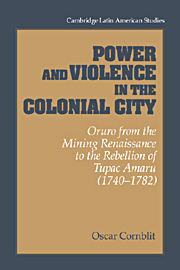 Power and Violence in the Colonial City
Power and Violence in the Colonial City Book contents
- Frontmatter
- Contents
- List of figure, maps, and tables
- Preface
- Map 1 Present-day Bolivia and surrounds
- Map 2 Principal routes of the Viceroyalty of Peru (second half of the eighteenth century)
- 1 Oruro between two epochs: a mining cycle
- 2 Under Spanish law
- 3 Oruro in 1741: details of a stormy election
- 4 The people
- 5 “Madmen, comedians, and hypocrites”
- 6 Captains of shipwreck
- 7 Returning to the known
- 8 “The fruits of the earth”
- 9 The end of an epoch: the Indian uprisings of 1780–1781
- 10 Oruro in the economic and geopolitical context of the epoch (c. 1780–1781)
- 11 The Oruro uprising
- 12 The voice of the rebels
- 13 Picking up the pieces
- Appendix A Indian raids on Oruro, 1781: testimonies
- Appendix B Testimonies of inhabitants of the city
- Appendix C Table of public jobs in Oruro, 1730–1784
- Bibliography
- Index
- CAMBRIDGE LATIN AMERICAN STUDIES
10 - Oruro in the economic and geopolitical context of the epoch (c. 1780–1781)
Published online by Cambridge University Press: 30 March 2010
- Frontmatter
- Contents
- List of figure, maps, and tables
- Preface
- Map 1 Present-day Bolivia and surrounds
- Map 2 Principal routes of the Viceroyalty of Peru (second half of the eighteenth century)
- 1 Oruro between two epochs: a mining cycle
- 2 Under Spanish law
- 3 Oruro in 1741: details of a stormy election
- 4 The people
- 5 “Madmen, comedians, and hypocrites”
- 6 Captains of shipwreck
- 7 Returning to the known
- 8 “The fruits of the earth”
- 9 The end of an epoch: the Indian uprisings of 1780–1781
- 10 Oruro in the economic and geopolitical context of the epoch (c. 1780–1781)
- 11 The Oruro uprising
- 12 The voice of the rebels
- 13 Picking up the pieces
- Appendix A Indian raids on Oruro, 1781: testimonies
- Appendix B Testimonies of inhabitants of the city
- Appendix C Table of public jobs in Oruro, 1730–1784
- Bibliography
- Index
- CAMBRIDGE LATIN AMERICAN STUDIES
Summary
The uprisings of the Indian groups and rebels of Peru took place during the reign of Charles III (1759–88), precisely when the modernization methods of the Bourbon monarch were at their apogee. The administration's initial reforms had already been introduced by the first kings of the new dynasty (Philip V and his successors, Ferdinand VI), but during the reign of Charles III it was possible to combine experience in administrative reform with the sometimes brilliant work of ministers and officials such as Aranda, Floridablanca, Campomanes, Jovellanos, Cabarrús, Olavide, and José de Gálvez. The Caroline administration made a notable effort to bring things up to date and to introduce French influences. They originated projects to foster industrial growth, bureaucratic efficiency, and the consolidation of military power.
In the case of Peru and Alto Peru (the latter had been incorporated in 1776 into the new viceroyalty of Rio de la Plata) all this implied profound changes, both in the internal structure of society and in external relations with other regions of Spanish colonization. Still, by the beginning of the 1770s, Lima, capital of the viceroyalty of Peru, occupied a strategic and economically privileged position in the empire, partly as a supplier of resources for the crown and partly as a commercial distribution center for the mining settlements of Alto Peru.
This situation gradually declined throughout the eighteenth century, particularly because of the overwhelming threat presented by Buenos Aires. This was the cheapest port for the importation of European products, which were subsequently sold in the markets of Charcas and Chile. Metal from Alto Peru also began to be exported from there.
- Type
- Chapter
- Information
- Power and Violence in the Colonial CityOruro from the Mining Renaissance to the Rebellion of Tupac Amaru (1740–1782), pp. 129 - 136Publisher: Cambridge University PressPrint publication year: 1995


